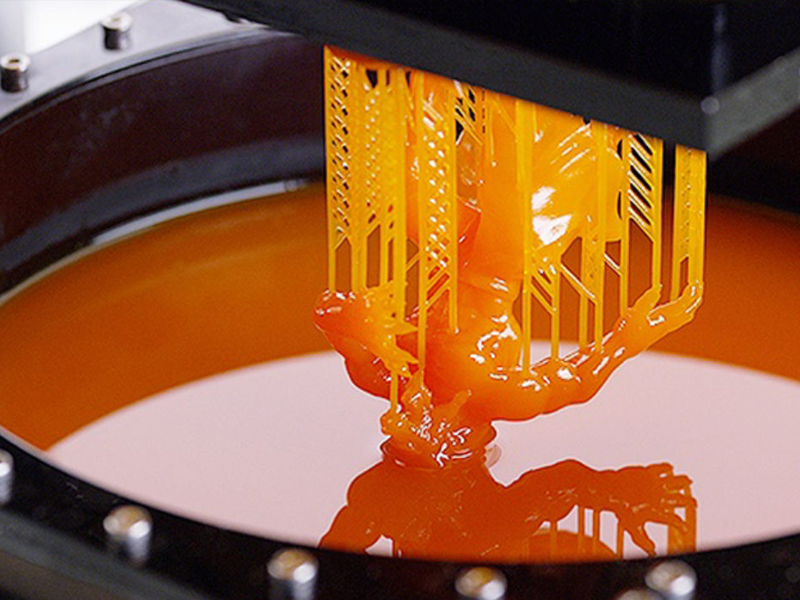Stereolithography (SLA) is a type of 3D printing technology that uses a laser to cure a photopolymer resin into a solid object. It is one of the oldest forms of 3D printing and it is known for producing high-resolution parts with smooth surface finishes. In an SLA printer, a vat of resin is exposed to a laser beam, which traces out the cross-section of the part layer by layer. As the laser hits the resin, it solidifies and adheres to the previous layer, forming the finished part. SLA printers are generally more expensive than other types of 3D printers, and the cost of materials can also be higher. However, they offer advantages in terms of print quality and speed, making them a good choice for certain applications. They are often used for prototyping and small-batch production of plastic parts, and they can be used to produce parts with a wide range of properties, including transparency, flexibility, and biocompatibility.
There are several key differences between Stereolithography (SLA) and other types of 3D printing technologies:
Process: SLA involves using a laser to cure liquid resin into solid parts layer by layer, while other technologies, such as Fused Deposition Modeling (FDM) and Selective Laser Sintering (SLS), use a nozzle to deposit material or a laser to sinter powdered material.
Material options: SLA can be used with a wide range of materials, including plastics, resins, and rubbers, while other technologies may be limited to specific materials or have a more limited range of material options.
Accuracy: SLA generally has a higher level of accuracy than other technologies, making it suitable for producing parts with tight tolerances and fine features.
Surface finish: SLA produces parts with a smooth and high-quality surface finish, while other technologies may produce parts with a rougher finish or more visible layers.
Speed: SLA has fast production speeds, making it suitable for high-volume production of parts, while other technologies may have slower production speeds.
Ultimately, the choice of 3D printing technology will depend on the specific requirements of the project, including the desired material, accuracy, surface finish, and production speed.
Stereolithography (SLA) is a type of 3D printing technology that uses a laser to cure liquid resin into solid parts layer by layer. SLA has several benefits, including:
High accuracy: SLA has a high level of accuracy, making it suitable for producing parts with tight tolerances and fine features.
Good surface finish: SLA produces parts with a smooth and high-quality surface finish, making it suitable for producing parts that will be visible or will require a high level of finish.
Wide range of materials: SLA can be used with a wide range of materials, including plastics, resins, and rubbers, allowing for a wide range of applications.
High resolution: SLA has a high resolution, allowing it to produce parts with small features and high levels of detail.
Fast production speeds: SLA has fast production speeds, making it suitable for high-volume production of parts.
Overall, SLA is a good choice for those looking for a 3D printing technology that can produce high-quality parts with a high level of accuracy and surface finish.
Stereolithography (SLA) is a type of 3D printing technology that is widely used in a variety of industries, including:
Healthcare: SLA is used to produce custom medical implants, prosthetics, and other medical devices.
Aerospace: SLA is used to produce lightweight and complex parts for aircraft and spacecraft, including engine components and structural components.
Automotive: SLA is used to produce a wide range of automotive parts, including engine components, transmission parts, and structural components.
Consumer products: SLA is used to produce a wide range of consumer products, including electronics, toys, and sporting goods.
Defense: SLA is used to produce a variety of parts for military equipment, including aircraft and ground vehicles.
Education: SLA is used in education to help students learn about 3D printing and prototyping, and to produce low-cost prototypes and models.
Overall, SLA is a versatile 3D printing technology that is widely used in a variety of industries due to its ability to produce high-quality parts with a high degree of accuracy and surface finish.
The cost of using Stereolithography (SLA) 3D printing technology can vary significantly depending on a number of factors, including:
Material: Different materials have different costs, and the cost of the material will be a significant factor in the overall cost of the parts.
Size and complexity of the parts: Larger and more complex parts will generally be more expensive to produce than smaller, simpler parts.
Quantity: The cost of producing parts using SLA tends to decrease as the quantity increases, so producing a large number of parts can result in a lower overall cost per part.
Post-processing: The cost of post-processing, such as cleaning and curing, can also impact the overall cost of the parts.
Overall, the cost of producing parts using SLA will depend on the specific requirements of the project, and it is difficult to provide a general estimate without more information. It is generally advisable to obtain quotes from multiple 3D printing service providers to get a sense of the cost for your specific project.
